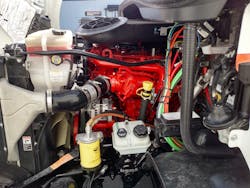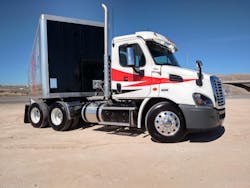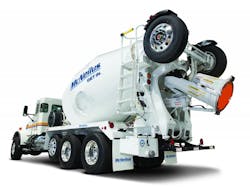Light weight is the point of Cummins’ X12 truck diesel, due for use in North America in six to nine months. The bottom line is the X12’s stated dry weight (without fluids) of 2,050 pounds, or 150 to 400 pounds less than comparable engines now on the market. Yet it offers the healthy horsepower and torque ratings of a larger diesel, and it performs like one.
That’s what I found on a drive of a Freightliner Cascadia tractor fitted with an X12, during Conexpo in Las Vegas earlier this year. The demo rig included a van carrying a moderate load and freshly decaled with graphics promoting this engine. Mario Sanchez, director of on-highway marketing communications, had it waiting at Cummins’ new distributorship in North Las Vegas, just off Interstate 15.
The new 11.8-liter X12 is an altogether different engine than the current 11.9-liter ISX12, which shared basic designs with the big 14.9-liter ISX15, Sanchez said. The X12 is based on the ISG12 introduced several years ago for the China market, where it’s built, and thousands of them have together run more than 1 billion miles. It has been refined for other markets and is now being sold in Central and South America, where smaller engines are more widely used. During an introduction last summer, Cummins executives said the X12 will come to North America in the first quarter of 2018. That’s still the schedule.
My drive started off inauspiciously, as in red face. In pulling out of the lot and onto a wide street, I began shifting the transmission like a 9-speed, trying to go from low-range 4th to high-range 5th, and whoa—it wouldn’t work. After grappling with the lever, clutch, and accelerator for several minutes, I pulled to the curb so Terry Milller, a Cummins mechanical engineering technician and the guy who drove the rig from the Midwest to Vegas, could run up from a chase car and remind me: “It’s a 10-speed.” Oh, heh-heh, right. I was skipping 6th gear and actually going for 7th, which was too much of a ratio spread, and that explained all the gear grinding. “What happens in Vegas stays in Vegas,” Sanchez graciously proclaimed, but now you know the story anyway.
From then on, it was smooth shifting out to the interstate and north to the Las Vegas Motor Speedway. There I exited onto surface streets that skirt the complex and backtracked to Las Vegas Boulevard. Here, far north of the Strip, the boulevard is two-lane State Route 604 that parallels I-15, climbing a brief but stiff grade until it junctions with the interstate. I took the on-ramp and followed 15 northeasterly to U.S. 93, then, at Sanchez’s suggestion, swung north to find some more serious upgrades.
So far, the X12 proved plenty gutsy enough to handle our gross weight of 55,000 or so pounds, typical of what a regional delivery tractor might face, Sanchez said, though less than what a loaded-to-the-gills dumper or mixer would weigh. Vocational is one of the “medium-bore” model’s main targets because they are weight-sensitive, and a 12-liter engine makes sufficient power for such service. Truck builders currently serve this application with their proprietary 11- and 13-liter-class engines. Some also offer the current (but heavy) 11.9-liter Cummins X12, and, for mixer chassis and trash trucks, the midrange-size 8.9-liter ISL9 and newer L9.
While cruising on the level, the X12 spun an indicated 1,375 rpm at 65 mph: faster than a normal long-haul highway tractor, especially in these days of “downsped” diesels that cruise at 1,100 rpm or thereabouts. The gearing on this Freightliner was for a regional tractor that sees numerous stops and starts and for varying freeway speeds. It kept revs in a livelier range, so the engine responded well. A vocational truck will have shorter gearing and the engine will spin faster at cruise. The X12 is quiet at cruising speed and added little or nothing to well-controlled road and wind sounds made by the Freightliner as it bored through the desert air. Often the engine was so quiet that I had to shift by tach rather by ear. And, “See? We are talking in normal tones,” Sanchez said proudly.
When we encountered a few 3- to 4-percent upgrades on U.S. 93, the engine slowed a bit but never faltered. I downshifted to 9th once or twice, but otherwise stayed in 10th and used the diesel’s healthy torque to bring us over the crests. The X12 felt like an X13.5, if there were such a Cummins model, or a 13-liter-class diesel from the truck builders. The X12 will be rated from 350 to 475 horsepower and 1,250 to 1,700 lb.-ft. Thirteen-liter diesels now go as much as 510 horsepower and 1,750 lb-ft.— one of which I recently drove—but under most circumstances, a driver would barely notice the difference.
The X12’s engine brake was fairly strong, though I didn’t downshift enough to really test the available retarding horsepower, claimed to be as much as 450, because the rig’s service brakes were very good. Last August, at the introduction of the X12 and X15, I did drive an X12-powered tractor with an Eaton automated transmission that aggressively downshifted, and the engine brake brought the tractor-trailer almost to a crawl. I was rather impressed.
At that intro, Cummins executives talked proudly about the X12’s weight. Jim Fier, VP of engineering, said his team cut pounds wherever possible from the engine.
“The block uses minimal material but is reinforced by an innovative network of supports,” he said. “They have even eliminated unnecessary material from the flywheel housing to reduce weight.” Those supports are ribs cast vertically into the block, which is made of gray iron, not the more expensive compacted graphic iron used by competitors, said Sanchez, who was a Cummins engineer before he became a marketer. Most of the ribs are hidden by accessories, but one can still appreciate the lightweight results.
So far, none of Cummins’ OEM customers has committed to offering the X12, but Sanchez said his company is talking to several of them about it. And 30 test engines are now operating in regional tractors, like this Freightliner, and in vocational trucks, including concrete mixers. He indicated that the chief competitors are the OEMs’ own 11-liter diesels. I’ve asked executives at several truck builders if they will offer the X12, and all responded with the same words: “We’re evaluating it.”
Later I talked with a product manager at one of the builders about the X12, and he privately said, “I hope we do use it, because it would give us a more complete selection for our customers. But I also can look through the corporate eyeglasses, and I understand that we’d like customers to take our own engines. It makes more business sense for us.”
That’s part of vertical integration, which was once confined to Mack but over the years has spread through all the builders, especially since Europeans with their tradition of proprietary powertrains have taken ownership of Mack and other old-line American builders. Acknowledging that challenge to Cummins, Sanchez said, “We are defending ourselves with the right products. We are not going head-to-head with our customers, who all have 13-liter engines. We have the X15, and with the X12 we have something smaller and lighter, something they don’t have, even in their 11-liter engines.”
That jibes with what a European exec told me last year: “I believe Cummins will stay relevant to the market. They are smart, and they offer products that the market needs.” The X12 falls into that category, and may well become as valuable a diesel as any.







